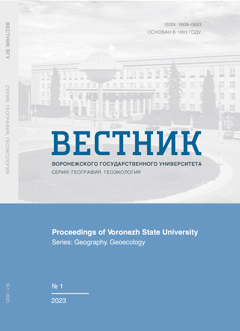Реакция на засуху различных линий армянской кукурузы в зависимости от почвенно-климатических условий
Аннотация
Изучилась реакция на засуху по кинематическим профилям четырех линий кукурузы с контрастной чувствительностью к стресс-фактору в зависимости от почвенно-климатических условий вместе с контрольной инбредной линией B73. Отмечено, что засухоустойчивость сильно уменьшала параметры роста листьев, включая скорость удлинения и конечную длину пятого листа. Было показано, что фенотипические различия между линиями, различающимися по географическому происхождению (армянские образцы и В73) и толерантности к засухе, могут быть идентифицированы на стадии рассады путем измерения общей длины, значений осмотического давления и водного потенциала пятого листа кукурузы.
Скачивания
Литература
2.Kirakosyan А. А. Ispol'zovanie yazyka MATLAB vkachestve ehkspress-metoda otsenki ehksperimental'nykhrezul'tatov / А. А. Kirakosyan, А. R. Sukiasyan // Informat-sionnye tekhnologii : Mezhdunarodnaya molodezhnaya konferentsiya, 23-25 iyunya 2005 g. – Erevan, 2005. – S. 34-37.
3.Boyer J. S. Plant productivity and environment /J. S. Boyer. // Science. – 1982. – Vol. 218. – P. 443-448.
4.Genetic Properties of the Maize Nested Association Mapping Population / Michael D. McMullen [et al.] // Sci-ence. – 2009. – Vol. 325, No 737. – P. 737-740.
5.Cruz de Carvalho M. H. Drought stress and reactiveoxygen species. Production, scavenging and signaling / Cruzde Carvalho M. H. // Plant Signal Behav. – 2008. – Vol. 3,No 3. – P. 156-165.
6.Heat stress causes alterations in the cell-wall polymers and anatomy of coffee leaves (Coffea arabica L.) /R. B. Lima [et al.] // Carbohydrate Polymers. – 2013. –Vol. 93. – P. 135-143.
7.Hyacinthe Le Gall Cell Wall Metabolism in Responseto Abiotic Stress / Hyacinthe Le Gall [et al.] // Plants. –2015. – Vol. 4. – P. 112-166.
8.Identification of cell wall genes modified by a permissive high temperature in Chinese cabbage / K. A. Yang[et al.] // Plant Sci. – 2006. – Vol. 171. – P. 175-182.
9.IPCC, 2014 : Climate Change 2014: Synthesis Report. Contribution of Working Groups I, II and III to theFifth Assessment Report of the Intergovernmental Panel onClimate Change / ed. R. K. Pachauri, L. A. Meyer. – Geneva, Switzerland, 2014. – 151 p.
10.Lobell D. B. Climate trends and global crop production since 1980 / D. B Lobell, W. Schlenker, J. Costa-Roberts // Science. – 2011. – Vol. 333, No 6042. – P. 616-620.
11.Ranking the World's Most Water-Stressed Countries in 2040 / A. Maddocks [et al.]. – 2015. – August 26. – URL: http://www.wri.org/blog/2015/08/ranking-world%E2%80%99s-most-water-stressed-countries-2040
12.Responses to abiotic stresses / Bray E. A. [et al.] //W. Gruissem Biochemistry and Molecular Biology of Plants/ W. Gruissem, B. Buchannan, R. Jones; American Societyof Plant Physiologists. – Rockville, MD, 2000. – P. 1158-1249.
13.Temperature responses of roots: impact on growth,root system architecture and implications for phenotyping /K. A. Nagel [et al.] // Functional Plant Biology. – 2009. –Vol. 36. – P. 947-959.
14.Tollenaar M. Yield potential, yield stability andstress tolerance in maize / M. Tollenaar, E. A. Lee // FieldCrops Research. – 2002. – Vol. 75. – P. 161-169.
15.Transgenic Tobacco Plants Overexpressing a GrassPpEXP1 Gene Exhibit Enhanced Tolerance to Heat Stress/ Q. Xu [et al.] // PLoS One. – 2014. – Vol. 9. – e100792.











